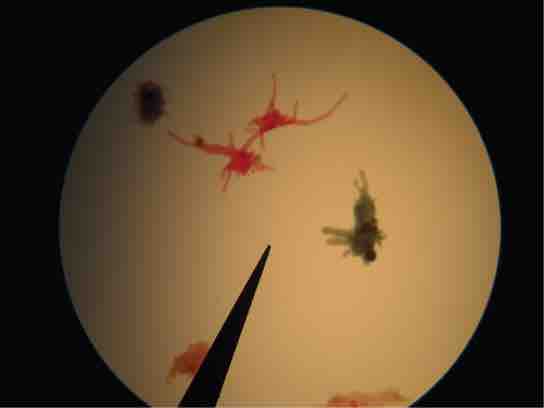Amoebozoa
Protists are eukaryotic organisms that are classified as unicellular, colonial, or multicellular organisms that do not have specialized tissues. This identifying property sets protists apart from other organisms within the Eukarya domain. The amoebozoans are classified as protists with pseudopodia which are used in locomotion and feeding. Amoebozoans live in marine environments, fresh water, or in soil. In addition to the defining pseudopodia, they also lack a shell and do not have a fixed body. The pseudopodia which are characteristically exhibited include extensions which can be tube-like or flat lobes, rather than the hair-like pseudopodia of rhizarian amoeba . Rhizarian amoeba are amoeboids with filose, reticulose, or microtubule-supported pseudopods and include the groups: Cercozoa, Foraminifera, and Radiolaria and are classified as bikonts. The Amoebozoa include several groups of unicellular amoeba-like organisms that are free-living or parasites that are classified as unikonts. The best known and most well-studied member of this group is the slime mold. Additional members include the Archamoebae, Tubulinea, and Flabellinea.

Pseudopodia structures
Amoebae with tubular and lobe-shaped pseudopodia, such as the ones seen under this microscope, would be morphologically classified as amoebozoans.
Slime Molds
A subset of the amoebozoans, the slime molds, has several morphological similarities to fungi that are thought to be the result of convergent evolution. For instance, during times of stress, some slime molds develop into spore-generating fruiting bodies, similar to fungi.
The slime molds are categorized on the basis of their life cycles into plasmodial or cellular types. Plasmodial slime molds are composed of large, multinucleate cells that move along surfaces like an amorphous blob of slime during their feeding stage. Food particles are lifted and engulfed into the slime mold as it glides along. Upon maturation, the plasmodium takes on a net-like appearance with the ability to form fruiting bodies, or sporangia, during times of stress . Haploid spores are produced by meiosis within the sporangia. These spores can be disseminated through the air or water to potentially land in more favorable environments. If this occurs, the spores germinate to form ameboid or flagellate haploid cells that can combine with each other and produce a diploid zygotic slime mold to complete the life cycle.
Badhamia utricularis
Badhamia utricularis: an example of a plasmodial slime mold with the ability to form a fruiting body.
The cellular slime molds function as independent amoeboid cells when nutrients are abundant . When food is depleted, cellular slime molds pile onto each other into a mass of cells that behaves as a single unit called a slug. Some cells in the slug contribute to a 2–3-millimeter stalk, drying up and dying in the process. Cells atop the stalk form an asexual fruiting body that contains haploid spores. As with plasmodial slime molds, the spores are disseminated and can germinate if they land in a moist environment. One representative genus of the cellular slime molds is Dictyostelium, which commonly exists in the damp soil of forests.
Plasmodial slime mold: Physarum polycephalum
Physarum polycephalum is an example of a cellular slime mold.
Archamoebae, Flabellinea, and Tubulinea
The Archamoebae are a group of Amoebozoa distinguished by the absence of mitochondria. They include genera that are internal parasites or commensals of animals (Entamoeba and Endolimax). A few species are human pathogens, causing diseases such as amoebic dysentery. The other genera of archamoebae live in freshwater habitats and are unusual among amoebae in possessing flagella. Most have a single nucleus and flagellum, but the giant amoeba, Pelomyxa, has many of each.
The Tubulinea are a major grouping of Amoebozoa, including most of the larger and more familiar amoebae like Amoeba, Arcella, and Difflugia. During locomotion, most Tubulinea have a roughly cylindrical form or produce numerous cylindrical pseudopods. Each cylinder advances by a single central stream of cytoplasm, granular in appearance, and has no subpseudopodia. This distinguishes them from other amoeboid groups, although in some members this is not the normal type of locomotion.